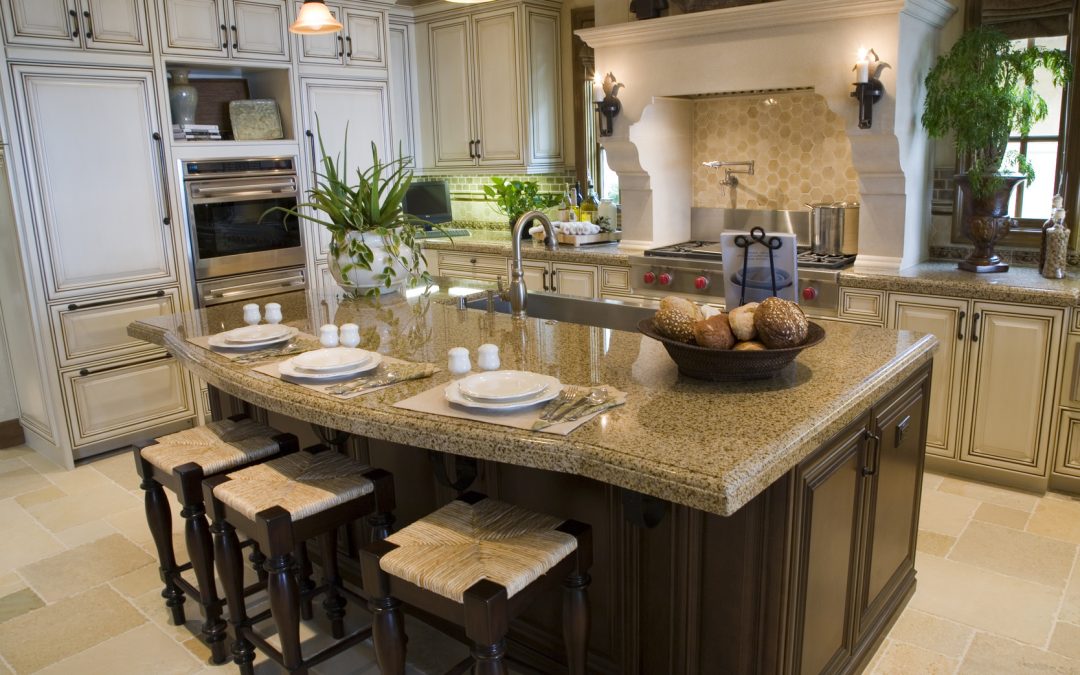A Long History
During the colonial era, America adopted the kitchen island and there’s a good reason why it became a tradition. Whether you want a larger workspace, additional storage, or a place for family and friends to gather, kitchen islands are a great feature and work well for most kitchen layouts. At LJ’s we’d love to discuss the possible kitchen island solutions to transform your space.
We work closely with you throughout the whole process, from planning through the implementation.
The Island Advantage
There are a number of reasons a kitchen island could be right for your kitchen and lifestyle, including:
- A place to entertain guests
- Family gathering area
- Added market value to your home
- Additional food prep space
- More storage
Entertainment
Kitchen islands can serve as a fun alternative place to sit; add bar stools to match or make a statement. When entertaining guests, this allows you to do last-minute food preparation and still carry on a conversation.
Family Gathering Spot
A kitchen island can be a fun change of scene from the dining room. Besides, you don’t even need to move the hot dishes to the table or come back to the kitchen to get seconds. Your kitchen island can become the perfect spot for family game night!
Increased Market Value
Kitchen island solutions add value to your house. While maintenance investments are the most important, kitchens and bathrooms are high up on the list for getting a good return on investment. In fact, builders and designers say it is the most cost effective way to add value to your kitchen. If you are planning to sell your house down the road, this is something to keep in mind.
More Kitchen Prep Space? Yes, Please!
Do you ever find yourself making lasagna or baking cookies only to run out of workspace? You roll out the pie dough and hope it gets to the right thickness before it runs off the counter.
Kitchen island solutions add more space to allow you to focus on cooking rather than rearranging fruit bowls and appliances to create counter space.
Extra Storage
With more countertop space, you have room to store your mixer or waffle maker without making the room look cluttered. Everything has its place!
Types of Kitchen Islands
After you’ve thought about the main reasons you would like to invest in a kitchen island, consider how the different types of counters would best serve that purpose.
Main Categories of Kitchen Islands Include:
- Simple countertop
- Multi-level
- Sink and/or stove top
Kitchen Island Sub-Types
- Dining
- Cooking
- Cooking and eating (two levels)
- L-shaped
- T-shaped
- Curved
- Open shelving
- Moveable cart
- Tiny (unattached table)
Amenities to Add
- Drawers
- Shelves
- Cabinets
- Dishwashers
- Refrigeration
- Cook tops
- Sinks
- Butcher blocks
- Wine storage
- Pet station nooks
- Overhead lighting
Consider Your Existing Kitchen
There are so many possibilities and great designs. We get excited just thinking about it! However, in order for the kitchen island to properly serve its intended function, you should keep in mind your current kitchen design and how the island will fit into the picture.
Some kitchen island solutions might look great in a magazine, but that doesn’t necessarily mean you’ve found what you’re looking for. It could be the perfect kitchen island, but consider how it will function in your space before materials arrive and hammers start pounding away.
Would the kitchen island overwhelm the room or impede traffic flow? While many designers like to make kitchen islands the focal point, when you walk in the room you want the island to be the first thing you notice in a good way! You want to enjoy it, not bump into it.
Spacing Specifics
To assure smooth traffic flow, experts suggest placing kitchen islands 4 to 9 feet away from other major areas such as your sink, stove, and refrigerator. Allot 60” between the wall and the dining counter of your kitchen island. Allow 42” between wall cabinets and your kitchen island; 48” to make it handicap accessible.
Think vertically as well. Pendant lights and vent hoods should be 30” above the countertop. For the countertop itself, ask yourself how you will use it. A counter 36” is the standard height and great for sinks, but 30” is helpful for kneading and rolling out dough because you can achieve a better downward force at that height. If you make bread a lot – or enter pie-baking contests – this is something to consider!
Another option is to have a counter with two levels to get the best of both worlds.
Then there’s the length of the kitchen island. If your kitchen island is standard height, the overhang for seating should be 15”. However, if you pair bar stools with a 42” counter, the overhang need only be 12” since our knees don’t bend as much sitting at that height.
To sum it up, things to consider include:
- Your workflow and traffic patterns
- How you typically utilize the space (What are your main activities?)
- What you hope to achieve with the space (I want it to be easier to __________.)
Cost
Our designers can help you create something you’ll love, whatever your budget.
- Table or rolling cart, $200+
- Basic kitchen island, $600+
- All the bells and whistles, possibly up to $5,000+
Contact Us to Get Started!
LJ’s Kitchens & Interiors provides design expertise and installation. Contact us to start designing your kitchen island! We work closely with you to achieve your goals for both function and design.
Centrally located in Mt. Pleasant since 1976, our staff has a combined 75 years of experience. Contact us today for all of your kitchen island solutions!
Links:
http://www.countryliving.com/home-design/decorating-ideas/advice/g1429/kitchen-islands/
https://www.thisoldhouse.com/ideas/all-about-kitchen-islands
http://freshome.com/kitchen-island-ideas/
https://www.pinterest.com/explore/kitchen-island-makeover/
http://www.hgtv.com/design/decorating/clean-and-organize/which-home-improvements-pay-off









